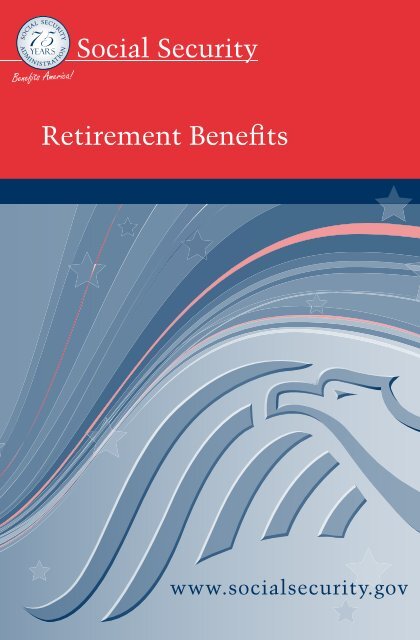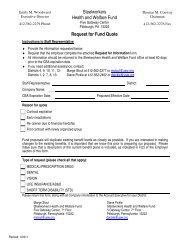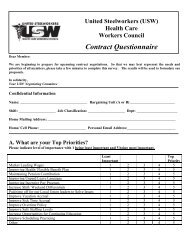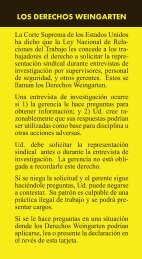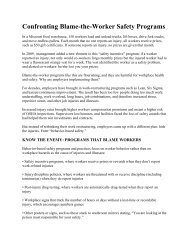Social Security Retirement Benefits
Social Security Retirement Benefits
Social Security Retirement Benefits
- No tags were found...
Create successful ePaper yourself
Turn your PDF publications into a flip-book with our unique Google optimized e-Paper software.
YEARS<strong>Retirement</strong> <strong>Benefits</strong>
Contact <strong>Social</strong> <strong>Security</strong>Visit our websiteOur website, www.socialsecurity.gov, is a valuableresource for information about all of <strong>Social</strong> <strong>Security</strong>’sprograms. At our website you also can:• Apply for certain kinds of benefits;• Get the address of your local <strong>Social</strong> <strong>Security</strong> office;• Request a <strong>Social</strong> <strong>Security</strong> Statement or a replacementMedicare card; and• Find copies of our publications.Call our toll-free numberIn addition to using our website, you can call us tollfreeat 1-800-772-1213. We treat all calls confidentially.We can answer specific questions from 7 a.m. to 7 p.m.,Monday through Friday. We can provide informationby automated phone service 24 hours a day. If you aredeaf or hard of hearing, you may call our TTY number,1-800-325-0778.We also want to make sure you receive accurate andcourteous service. That is why we have a second <strong>Social</strong><strong>Security</strong> representative monitor some telephone calls.
What’s inside<strong>Social</strong> <strong>Security</strong> and your retirement plans.. . 4Your retirement benefits .. . . . . . . . . . . . . . . . 4Family benefits. . . . . . . . . . . . . . . . . . . . . . . . . . 9What you need to know when youare eligible for retirement benefits .. . . . . . . 12A word about Medicare. . . . . . . . . . . . . . . . . 16
<strong>Social</strong> <strong>Security</strong> and your retirement plans<strong>Social</strong> <strong>Security</strong> is part of the retirement plan of almostevery American worker. If you are among the 96 percentof workers who are covered under <strong>Social</strong> <strong>Security</strong>, youshould know how the system works and what you shouldreceive from <strong>Social</strong> <strong>Security</strong> when you retire. Thisbooklet explains how you qualify for <strong>Social</strong> <strong>Security</strong>benefits, how your earnings and age can affect yourbenefits, what you should think about in deciding whento retire and why you should not count only on <strong>Social</strong><strong>Security</strong> for your retirement income.This booklet provides basic information on <strong>Social</strong><strong>Security</strong> retirement benefits and is not intended to answerall questions. For specific information about your situation,you should talk with a <strong>Social</strong> <strong>Security</strong> representative.Your retirement benefitsHow do you qualify for retirement benefits?When you work and pay <strong>Social</strong> <strong>Security</strong> taxes, youearn “credits” toward <strong>Social</strong> <strong>Security</strong> benefits.The number of credits you need to get retirementbenefits depends on when you were born. If you wereborn in 1929 or later, you need 40 credits (10 yearsof work).If you stop working before you have enough creditsto qualify for benefits, the credits will remain on your<strong>Social</strong> <strong>Security</strong> record. If you return to work lateron, you can add more credits so that you qualify. Noretirement benefits can be paid until you have therequired number of credits.How much will your retirement benefit be?Your benefit payment is based on how much youearned during your working career. Higher lifetimeearnings result in higher benefits. If there were some4
years when you did not work or had low earnings,your benefit amount may be lower than if you hadworked steadily.Your benefit payment also is affected by the age atwhich you decide to retire. If you retire at age 62 (theearliest possible retirement age for <strong>Social</strong> <strong>Security</strong>),your benefit will be lower than if you wait until later toretire. This is explained in more detail on pages 6-8.NOTE: Each year, about three months before yourbirthday, you receive a <strong>Social</strong> <strong>Security</strong> Statement. It canbe a valuable tool to help you plan a secure financialfuture. It provides you with a record of your earningsand gives estimates of what your <strong>Social</strong> <strong>Security</strong> benefitswould be at different retirement ages. It also gives anestimate of the disability benefits you could receive ifyou become severely disabled before retirement, as wellas estimates of the survivors benefits <strong>Social</strong> <strong>Security</strong>would provide your spouse and eligible family memberswhen you die.You can get retirement benefit estimatesYou can use the online <strong>Retirement</strong> Estimator to getimmediate and personalized retirement benefit estimatesto help you plan for your retirement. The online<strong>Retirement</strong> Estimator is a convenient, secure and quickfinancial planning tool, since it eliminates the need tomanually key in years of earnings information. Theestimator also will let you create “what if” scenarios.You can, for example, change your “stop work” dates orexpected future earnings to create and compare differentretirement options.For more information, ask for Online <strong>Retirement</strong>Estimator (Publication No. 05-10510) or How To Use TheOnline <strong>Retirement</strong> Estimator (Publication No. 05-10511)or visit our website at www.socialsecurity.gov/estimator.5
Full retirement ageIf you were born in 1942 or earlier, you are alreadyeligible for your full <strong>Social</strong> <strong>Security</strong> benefit. If you wereborn from 1943 to 1960, the age at which full retirementbenefits are payable increases gradually to age 67. Thefollowing chart will guide you in determining your fullretirement age.Age to receive full <strong>Social</strong> <strong>Security</strong> benefitsYear of birth1943-1954 66Full retirement age1955 66 and 2 months1956 66 and 4 months1957 66 and 6 months1958 66 and 8 months1959 66 and 10 months1960 and later 67NOTE: People who were born on January 1 ofany year should refer to the previous year.Early retirementYou can get <strong>Social</strong> <strong>Security</strong> retirement benefits as earlyas age 62, but if you retire before your full retirementage, your benefits will be reduced, based on your age.For example, if you retire at age 62, your benefit wouldbe about 25 percent lower than what it would be if youwaited until you reach full retirement age.Some people stop working before age 62. But if theydo, the years with no earnings will probably mean alower <strong>Social</strong> <strong>Security</strong> benefit when they retire.6
NOTE: Sometimes health problems force peopleto retire early. If you cannot work because of healthproblems, you should consider applying for <strong>Social</strong> <strong>Security</strong>disability benefits. The amount of the disability benefitis the same as a full, unreduced retirement benefit. If youare receiving <strong>Social</strong> <strong>Security</strong> disability benefits when youreach full retirement age, those benefits will be convertedto retirement benefits. For more information, ask forDisability <strong>Benefits</strong> (Publication No. 05-10029).Delayed retirementYou may choose to keep working even beyond yourfull retirement age. If you do, you can increase yourfuture <strong>Social</strong> <strong>Security</strong> benefits in two ways.Each additional year you work adds another year ofearnings to your <strong>Social</strong> <strong>Security</strong> record. Higher lifetimeearnings may mean higher benefits when you retire.Also, your benefit will increase automatically by acertain percentage from the time you reach your fullretirement age until you start receiving your benefits oruntil you reach age 70. The percentage varies dependingon your year of birth. For example, if you were bornin 1943 or later, we will add 8 percent per year to yourbenefit for each year that you delay signing up for <strong>Social</strong><strong>Security</strong> beyond your full retirement age.NOTE: If you decide to delay your retirement,be sure to sign up for Medicare at age 65. In somecircumstances, medical insurance costs more if youdelay applying for it. Other information about Medicareis on pages 16 -17.Deciding when to retireChoosing when to retire is an important but personaldecision. Regardless of the age you choose to retire, it isa good idea to contact <strong>Social</strong> <strong>Security</strong> in advance to seewhich month is best to claim benefits. In some cases,your choice of a retirement month could mean higherbenefit payments for you and your family.7
In deciding when to retire, it is important toremember that financial experts say you will need70-80 percent of your preretirement income to have acomfortable retirement. Since <strong>Social</strong> <strong>Security</strong> replacesonly about 40 percent of preretirement income for theaverage worker, it is important to have pensions, savingsand investments.It may be to your advantage to have your <strong>Social</strong><strong>Security</strong> benefits start in January, even if you do notplan to retire until later in the year. Depending on yourearnings and your benefit amount, it may be possible foryou to start collecting benefits even though you continueto work. Under current rules, many people can receivethe most benefits possible with an application that iseffective in January.You should apply for benefits about three monthsbefore the date you want your benefits to start. If youare not quite ready to retire, but are thinking aboutdoing so in the near future, you may want to visit <strong>Social</strong><strong>Security</strong>’s website to use our convenient and informativeretirement planner at www.socialsecurity.gov/retire.“Working beyond full retirementage can increase your benefits.”<strong>Retirement</strong> benefits for widows and widowersWidows and widowers can begin receiving <strong>Social</strong><strong>Security</strong> benefits at age 60, or at age 50 if they aredisabled. And they can take a reduced benefit on onerecord and later switch to a full benefit on the otherrecord. For example, a woman could take a reducedwidow’s benefit at 60 or 62 and then switch to herfull (100 percent) retirement benefit when she reachesfull retirement age. The rules vary depending on thesituation, so you should talk to a <strong>Social</strong> <strong>Security</strong>representative about the options available to you.8
Family benefits<strong>Benefits</strong> for family membersIf you are getting <strong>Social</strong> <strong>Security</strong> retirement benefits,some members of your family also can receive benefits.Those who can include:Spouses who are age 62 or older;• Spouses who are younger than 62, if they are takingcare of a child entitled on your record who is under age16 or disabled;• Former spouses, if they are age 62 or older (see“<strong>Benefits</strong> for a divorced spouse” on page 11);• Children up to age 18, or up to 19 if they are full-timestudents who have not yet graduated from high school;and• Disabled children, even if they are age 18 or older.If you become the parent of a child (including anadopted child) after you begin receiving benefits, let usknow about the child so we can decide if the child iseligible for benefits.NOTE: Children’s benefits are available only tounmarried children. However, in certain situations,benefits are payable to a disabled child who marriessomeone who is also eligible as a disabled child.Spouse’s benefitsA spouse who has not worked or who has lowearnings can be entitled to as much as one-half ofthe retired worker’s full benefit. If you are eligible forboth your own retirement benefits and for benefits as aspouse, we always pay your own benefits first. If yourbenefits as a spouse are higher than your retirementbenefits, you will get a combination of benefits equalingthe higher spouse benefit.9
Here is an example:Mary Ann qualifies for a retirement benefit of $250and a spouse’s benefit of $400. At her full retirement age,she will receive her own $250 retirement benefit, andwe will add $150 from her spouse’s benefit, for a total of$400. If she takes her retirement benefit before her fullretirement age, both amounts will be reduced.NOTE: Your current spouse cannot receive spouse’sbenefits until you file for retirement benefits. However, ifyou are full retirement age, you can apply for retirementbenefits and then request to have payments suspended.That way, your spouse can receive a spouse’s benefit andyou can earn delayed retirement credits until age 70.Maximum family benefitsIf you have children eligible for <strong>Social</strong> <strong>Security</strong>, eachwill receive up to one-half of your full benefit. But thereis a limit to the amount of money that can be paid to youand your family—usually 150-180 percent of your ownbenefit payment. If the total benefits due to your spouseand children are more than this limit, their benefits willbe reduced. Your benefit will not be affected.<strong>Benefits</strong> for a divorced spouseYour divorced spouse can get benefits on your <strong>Social</strong><strong>Security</strong> record if the marriage lasted at least 10 years.Your divorced spouse must be 62 or older and unmarried.The amount of benefits he or she gets has no effecton the amount of benefits you or your current spousecan get.Also, if you and your ex-spouse have been divorced forat least two years and you and your ex-spouse are at least62, he or she can get benefits even if you are not retired.11
What you need to know when youare eligible for retirement benefitsHow do you sign up for <strong>Social</strong> <strong>Security</strong>?You can apply for retirement benefits online atwww.socialsecurity.gov or you can call our tollfreenumber, 1-800-772-1213. Or you can make anappointment to visit any <strong>Social</strong> <strong>Security</strong> office to applyin person.Depending on your circumstances, you will needsome or all of the documents listed below. But do notdelay applying for benefits because you do not have allthe information. If you do not have a document youneed, we can help you get it.Information needed:• Your <strong>Social</strong> <strong>Security</strong> number;• Your birth certificate;• Your W-2 forms or self-employment tax return forlast year;• Your military discharge papers if you hadmilitary service;• Your spouse’s birth certificate and <strong>Social</strong> <strong>Security</strong>number if he or she is applying for benefits;• Children’s birth certificates and <strong>Social</strong> <strong>Security</strong>numbers, if you are applying for children’s benefits;• Proof of U.S. citizenship or lawful alien status if you(or a spouse or child applying for benefits) were notborn in the United States; and• The name of your financial institution, the routingnumber and your account number, so your benefits canbe deposited directly into your account.You will need to submit original documents or copiescertified by the issuing office. You can mail or bringthem to <strong>Social</strong> <strong>Security</strong>. We will make photocopies andreturn your documents.12
Right to appealIf you disagree with a decision made on your claim,you can appeal it. For an explanation of the steps youcan take, ask for The Appeals Process (Publication No.05-10041).You have the right to be represented by an attorneyor other qualified person of your choice. For moreinformation, ask for Your Right To Representation(Publication No. 05-10075).If you work and get benefits at the same timeYou can continue to work and still receive retirementbenefits. Your earnings in (or after) the month you reachyour full retirement age will not reduce your <strong>Social</strong><strong>Security</strong> benefits. However, your benefits will be reducedif your earnings exceed certain limits for the monthsbefore you reach your full retirement age. (See page 6 tofind your full retirement age.)Here is how it works:If you are younger than full retirement age, $1 inbenefits will be deducted for each $2 in earnings youhave above the annual limit.In the year you reach your full retirement age, yourbenefits will be reduced $1 for every $3 you earn over anannual limit until the month you reach full retirementage. Once you reach full retirement age, you can keepworking, and your <strong>Social</strong> <strong>Security</strong> benefit will not bereduced no matter how much you earn.If, during the year, your earnings are higher or lowerthan you estimated, let us know as soon as possible sowe can adjust your benefits.If you want more information on how earnings affectyour retirement benefit, ask for How Work Affects Your<strong>Benefits</strong> (Publication No. 05-10069), which has currentannual and monthly earnings limits.13
A special monthly ruleA special rule applies to your earnings for one year,usually your first year of retirement. Under this rule,you can receive a full <strong>Social</strong> <strong>Security</strong> check for anymonth you earn under a certain limit, regardless of youryearly earnings. If you are self-employed, the work youdo in your business is taken into consideration as well.If you want more information on how earnings affectyour retirement benefit, ask for How Work Affects Your<strong>Benefits</strong> (Publication No. 05-10069), which has currentannual and monthly earnings limits.Your benefits may be taxableAbout one-third of people who get <strong>Social</strong> <strong>Security</strong>have to pay income taxes on their benefits.• If you file a federal tax return as an “individual,”and your combined income* is between $25,000 and$34,000, you may have to pay taxes on up to 50 percentof your <strong>Social</strong> <strong>Security</strong> benefits. If your combinedincome* is more than $34,000, up to 85 percent of your<strong>Social</strong> <strong>Security</strong> benefits is subject to income tax.• If you file a joint return, you may have to pay taxeson 50 percent of your benefits if you and your spousehave a combined income* that is between $32,000and $44,000. If your combined income* is more than$44,000, up to 85 percent of your <strong>Social</strong> <strong>Security</strong>benefits is subject to income tax.• If you are married and file a separate return, youprobably will pay taxes on your benefits.At the end of each year, we will mail you a <strong>Social</strong><strong>Security</strong> Benefit Statement (Form SSA-1099) showingthe amount of benefits you received. You can use thisstatement when you complete your federal incometax return to find out if you have to pay taxes onyour benefits.14
Although you are not required to have federal taxeswithheld, you may find it easier than paying quarterlyestimated tax payments.For more information, call the Internal RevenueService’s toll-free telephone number, 1-800-829-3676,to ask for Publication 554, Tax Guide for Seniors, andPublication 915, <strong>Social</strong> <strong>Security</strong> And Equivalent Railroad<strong>Retirement</strong> <strong>Benefits</strong>.*On the 1040 tax return, your “combined income” isthe sum of your adjusted gross income plus nontaxableinterest plus one-half of your <strong>Social</strong> <strong>Security</strong> benefits.Pensions from work not coveredby <strong>Social</strong> <strong>Security</strong>If you get a pension from work where you paid <strong>Social</strong><strong>Security</strong> taxes, that pension will not affect your <strong>Social</strong><strong>Security</strong> benefits. However, if you get a pension fromwork that was not covered by <strong>Social</strong> <strong>Security</strong>—forexample, the federal civil service, some state or localgovernment employment or work in a foreign country—your <strong>Social</strong> <strong>Security</strong> benefit may be reduced.For more information, ask for Government PensionOffset (Publication No. 05-10007), for governmentworkers who may be eligible for <strong>Social</strong> <strong>Security</strong> benefitson the earnings record of a spouse; and WindfallElimination Provision (Publication No. 05-10045), forpeople who worked in another country or governmentworkers who also are eligible for their own <strong>Social</strong><strong>Security</strong> benefits.Leaving the United StatesIf you are a U.S. citizen, you can travel to or live inmost foreign countries without affecting your <strong>Social</strong><strong>Security</strong> benefits. There are, however, a few countrieswhere we cannot send <strong>Social</strong> <strong>Security</strong> payments. Thesecountries are Cambodia, Cuba, North Korea, Vietnamand areas that were in the former Soviet Union (other15
than Armenia, Estonia, Latvia, Lithuania and Russia).However, exceptions can be made for certain eligiblebeneficiaries in countries other than Cuba and NorthKorea. For more information about these exceptions,please contact your local <strong>Social</strong> <strong>Security</strong> office.If you work outside the United States, different rulesapply in determining if you can get benefits.For more information, ask for Your PaymentsWhile You Are Outside The United States (PublicationNo. 05-10137).A word about MedicareMedicare is a health insurance plan for people whoare age 65 or older. People who are disabled or havepermanent kidney failure or have amyotrophic lateralsclerosis (Lou Gehrig’s disease) can get Medicare atany age.Medicare has four parts• Hospital insurance (Part A) helps pay for inpatienthospital care and certain follow-up services.• Medical insurance (Part B) helps pay for doctors’services, outpatient hospital care and other medicalservices.• Medicare Advantage plans (Part C) are available inmany areas. People with Medicare Parts A and B canchoose to receive all of their health care servicesthrough a provider organization under Part C.• Prescription drug coverage (Part D) helps pay formedications doctors prescribe for medical treatment.16
If you are already getting <strong>Social</strong><strong>Security</strong> benefits when you turn 65,your Medicare starts automatically.NOTE: Residents of Puerto Ricoor foreign countries will not receivePart B automatically. They mustelect this benefit.If you are not getting <strong>Social</strong> <strong>Security</strong>, you shouldsign up for Medicare before your 65th birthday, even ifyou are not ready to retire. For more information, ask forMedicare (Publication No. 05-10043).Help with Medicare expenses for peoplewith low incomeIf you have a low income and few resources, yourstate may pay your Medicare premiums and, in somecases, other “out-of-pocket” medical expenses, such asdeductibles and coinsurance.Only your state can decide whether you qualifyfor help under this program. If you think you qualify,contact your state or local medical assistance (Medicaid)agency, social services or welfare office.“Extra help” with Medicare prescription costsIf you have limited income and resources, you mayqualify for extra help to pay for your prescription drugsunder Medicare Part D. <strong>Social</strong> <strong>Security</strong>’s role is to helpyou understand how you may qualify and to processyour application for extra help. To see if you qualify orto apply, call <strong>Social</strong> <strong>Security</strong>’s toll-free number or visitour website.17
YEARS<strong>Social</strong> <strong>Security</strong> AdministrationSSA Publication No. 05-10035ICN 457500Unit of Issue - HD (one hundred)January 2010 (Prior editions may be used)


